2.6: Hotspots
- Page ID
- 28221
\( \newcommand{\vecs}[1]{\overset { \scriptstyle \rightharpoonup} {\mathbf{#1}} } \)
\( \newcommand{\vecd}[1]{\overset{-\!-\!\rightharpoonup}{\vphantom{a}\smash {#1}}} \)
\( \newcommand{\id}{\mathrm{id}}\) \( \newcommand{\Span}{\mathrm{span}}\)
( \newcommand{\kernel}{\mathrm{null}\,}\) \( \newcommand{\range}{\mathrm{range}\,}\)
\( \newcommand{\RealPart}{\mathrm{Re}}\) \( \newcommand{\ImaginaryPart}{\mathrm{Im}}\)
\( \newcommand{\Argument}{\mathrm{Arg}}\) \( \newcommand{\norm}[1]{\| #1 \|}\)
\( \newcommand{\inner}[2]{\langle #1, #2 \rangle}\)
\( \newcommand{\Span}{\mathrm{span}}\)
\( \newcommand{\id}{\mathrm{id}}\)
\( \newcommand{\Span}{\mathrm{span}}\)
\( \newcommand{\kernel}{\mathrm{null}\,}\)
\( \newcommand{\range}{\mathrm{range}\,}\)
\( \newcommand{\RealPart}{\mathrm{Re}}\)
\( \newcommand{\ImaginaryPart}{\mathrm{Im}}\)
\( \newcommand{\Argument}{\mathrm{Arg}}\)
\( \newcommand{\norm}[1]{\| #1 \|}\)
\( \newcommand{\inner}[2]{\langle #1, #2 \rangle}\)
\( \newcommand{\Span}{\mathrm{span}}\) \( \newcommand{\AA}{\unicode[.8,0]{x212B}}\)
\( \newcommand{\vectorA}[1]{\vec{#1}} % arrow\)
\( \newcommand{\vectorAt}[1]{\vec{\text{#1}}} % arrow\)
\( \newcommand{\vectorB}[1]{\overset { \scriptstyle \rightharpoonup} {\mathbf{#1}} } \)
\( \newcommand{\vectorC}[1]{\textbf{#1}} \)
\( \newcommand{\vectorD}[1]{\overrightarrow{#1}} \)
\( \newcommand{\vectorDt}[1]{\overrightarrow{\text{#1}}} \)
\( \newcommand{\vectE}[1]{\overset{-\!-\!\rightharpoonup}{\vphantom{a}\smash{\mathbf {#1}}}} \)
\( \newcommand{\vecs}[1]{\overset { \scriptstyle \rightharpoonup} {\mathbf{#1}} } \)
\( \newcommand{\vecd}[1]{\overset{-\!-\!\rightharpoonup}{\vphantom{a}\smash {#1}}} \)
\(\newcommand{\avec}{\mathbf a}\) \(\newcommand{\bvec}{\mathbf b}\) \(\newcommand{\cvec}{\mathbf c}\) \(\newcommand{\dvec}{\mathbf d}\) \(\newcommand{\dtil}{\widetilde{\mathbf d}}\) \(\newcommand{\evec}{\mathbf e}\) \(\newcommand{\fvec}{\mathbf f}\) \(\newcommand{\nvec}{\mathbf n}\) \(\newcommand{\pvec}{\mathbf p}\) \(\newcommand{\qvec}{\mathbf q}\) \(\newcommand{\svec}{\mathbf s}\) \(\newcommand{\tvec}{\mathbf t}\) \(\newcommand{\uvec}{\mathbf u}\) \(\newcommand{\vvec}{\mathbf v}\) \(\newcommand{\wvec}{\mathbf w}\) \(\newcommand{\xvec}{\mathbf x}\) \(\newcommand{\yvec}{\mathbf y}\) \(\newcommand{\zvec}{\mathbf z}\) \(\newcommand{\rvec}{\mathbf r}\) \(\newcommand{\mvec}{\mathbf m}\) \(\newcommand{\zerovec}{\mathbf 0}\) \(\newcommand{\onevec}{\mathbf 1}\) \(\newcommand{\real}{\mathbb R}\) \(\newcommand{\twovec}[2]{\left[\begin{array}{r}#1 \\ #2 \end{array}\right]}\) \(\newcommand{\ctwovec}[2]{\left[\begin{array}{c}#1 \\ #2 \end{array}\right]}\) \(\newcommand{\threevec}[3]{\left[\begin{array}{r}#1 \\ #2 \\ #3 \end{array}\right]}\) \(\newcommand{\cthreevec}[3]{\left[\begin{array}{c}#1 \\ #2 \\ #3 \end{array}\right]}\) \(\newcommand{\fourvec}[4]{\left[\begin{array}{r}#1 \\ #2 \\ #3 \\ #4 \end{array}\right]}\) \(\newcommand{\cfourvec}[4]{\left[\begin{array}{c}#1 \\ #2 \\ #3 \\ #4 \end{array}\right]}\) \(\newcommand{\fivevec}[5]{\left[\begin{array}{r}#1 \\ #2 \\ #3 \\ #4 \\ #5 \\ \end{array}\right]}\) \(\newcommand{\cfivevec}[5]{\left[\begin{array}{c}#1 \\ #2 \\ #3 \\ #4 \\ #5 \\ \end{array}\right]}\) \(\newcommand{\mattwo}[4]{\left[\begin{array}{rr}#1 \amp #2 \\ #3 \amp #4 \\ \end{array}\right]}\) \(\newcommand{\laspan}[1]{\text{Span}\{#1\}}\) \(\newcommand{\bcal}{\cal B}\) \(\newcommand{\ccal}{\cal C}\) \(\newcommand{\scal}{\cal S}\) \(\newcommand{\wcal}{\cal W}\) \(\newcommand{\ecal}{\cal E}\) \(\newcommand{\coords}[2]{\left\{#1\right\}_{#2}}\) \(\newcommand{\gray}[1]{\color{gray}{#1}}\) \(\newcommand{\lgray}[1]{\color{lightgray}{#1}}\) \(\newcommand{\rank}{\operatorname{rank}}\) \(\newcommand{\row}{\text{Row}}\) \(\newcommand{\col}{\text{Col}}\) \(\renewcommand{\row}{\text{Row}}\) \(\newcommand{\nul}{\text{Nul}}\) \(\newcommand{\var}{\text{Var}}\) \(\newcommand{\corr}{\text{corr}}\) \(\newcommand{\len}[1]{\left|#1\right|}\) \(\newcommand{\bbar}{\overline{\bvec}}\) \(\newcommand{\bhat}{\widehat{\bvec}}\) \(\newcommand{\bperp}{\bvec^\perp}\) \(\newcommand{\xhat}{\widehat{\xvec}}\) \(\newcommand{\vhat}{\widehat{\vvec}}\) \(\newcommand{\uhat}{\widehat{\uvec}}\) \(\newcommand{\what}{\widehat{\wvec}}\) \(\newcommand{\Sighat}{\widehat{\Sigma}}\) \(\newcommand{\lt}{<}\) \(\newcommand{\gt}{>}\) \(\newcommand{\amp}{&}\) \(\definecolor{fillinmathshade}{gray}{0.9}\)To analyze plate movement more precisely, scientists study hotspots. First postulated by J. Tuzo Wilson in 1963, a hotspot is an area in the lithospheric plate where molten magma breaks through and creates a volcanic center, islands in the ocean and mountains on land [82]. As the plate moves across the hotspot, the volcano center becomes extinct because it is no longer over an active magma source. Instead, the magma emerges through another area in the plate to create a new active volcano. Over time, the combination of a moving plate and a stationary hotspot creates a chain of islands or mountains. The classic definition of hotspots states they do not move, although recent evidence suggests that there may be exceptions [83].
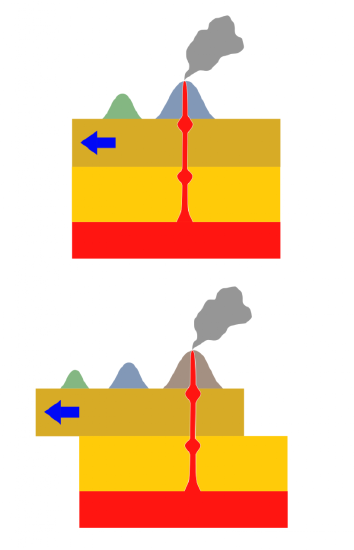
Hotspots are the only types of volcanism not associated with subduction or rifting zones at plate boundaries; they seem totally disconnected from any plate tectonics processes, such as earthquakes. However, there are relationships between hotspots and plate tectonics. There are several hotspots, current and former, that are believed to have begun at the time of rifting. Also, scientists use the age of volcanic eruptions and shape of the chain to quantify the rate and direction of plate movements relative to the hotspot.
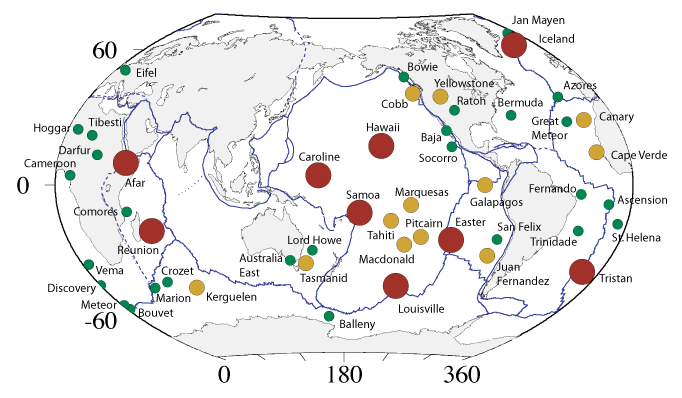
Scientists are divided over how magma is generated in hotspots. Some suggest that hotspots originate from super-heated material from as deep as the core that reaches the Earth’s crust as a mantle plume [84]. Others argue the molten material that feeds hotspots is sourced from the mantle [85]. Of course, it is difficult to collect data from these deep-Earth features due to the extremely high pressure and temperature [86].
The United States is home to two of the largest and best-studied hotspots: Hawaii and Yellowstone.
Hawaiian Hotspot
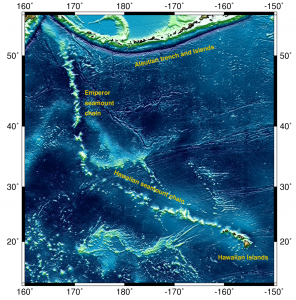
The active volcanoes in Hawaii represent one of the most active hotspot sites on earth. Scientific evidence indicates the Hawaiian hotspot is at least 80 million years old [90]. Geologists believe it is actually much older. However, any rocks with proof of this have been subducted under the ocean floor. The big island of Hawaii sits atop a large mantle plume that marks the active hotspot. The Kilauea volcano is the main vent for this hotspot and has been actively erupting since 1983. So the youngest islands are above the active hotspot and the oldest islands in the chain are the furthest away from the active hotspot.
This enormous volcanic island chain, much of which is underwater, stretches across the Pacific for almost 6,000 km. The seamount chain’s most striking feature is a sharp 60-degree bend located at the midpoint, which marks a significant change in plate movement direction that occurred 50 million years ago. The change in direction has been more often linked to a plate reconfiguration [91], but also to other things like plume migration [83].
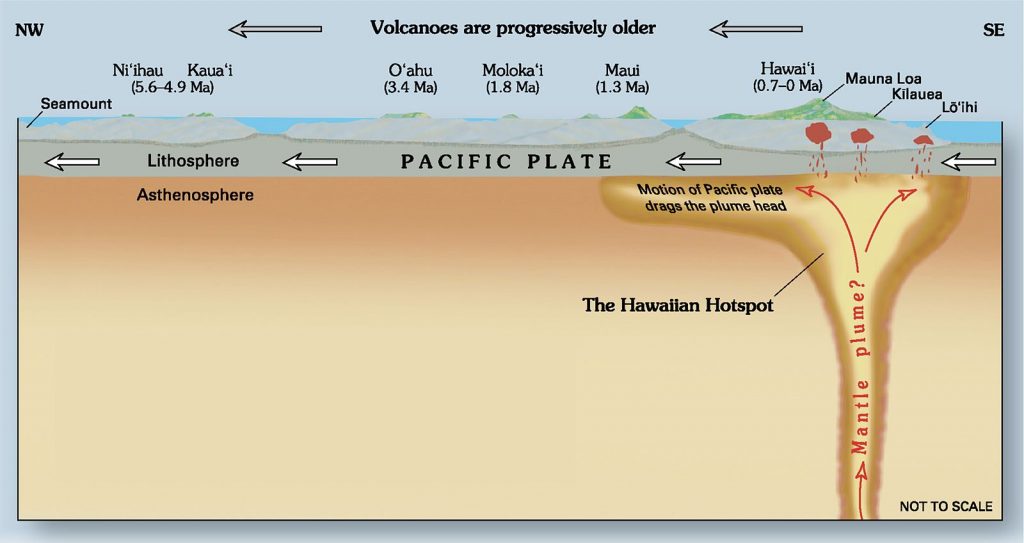
Yellowstone Hotspot
Like the Hawaiian version, the Yellowstone hotspot is formed by magma rising through the lithosphere. What makes it different is this hotspot is located under a thick, continental plate. Hawaii sits on a thin oceanic plate, which is easily breached by magma coming to the surface. At Yellowstone, the thick continental plate presents a much more difficult barrier for magma to penetrate. When it does emerge, the eruptions are generally much more violent. Thankfully they are also less frequent.

Over 15 million years of eruptions by this hotspot have carved a curved path across the western United States. It has been suggested the Yellowstone hotspot is connected to the much older Columbia River flood basalts [93] and even to 70 million-year-old volcanism found in the Yukon region of Canada [94].
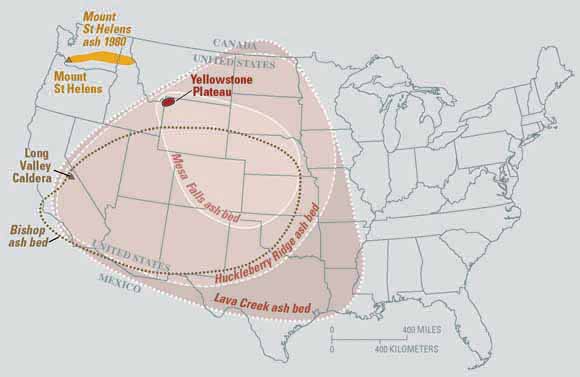
The most recent major eruption of this hotspot created the Yellowstone Caldera and Lava Creek tuff formation approximately 631,000 years ago [95]. The eruption threw 1,000 cubic kilometers of ash and magma into the atmosphere, some of which was found as far away as Mississippi. Should the hotspot erupt again, scientists predict it will be another massive event. This would be a calamity reaching far beyond the western United States. These super volcanic eruptions fill the earth’s atmosphere with so much gas and ash, they block sunlight from reaching the earth. Not only would this drastically alter climates and environments around the globe, but it could also affect worldwide food production.
References
- 82. Wilson, J. T. A possible origin of the Hawaiian Islands. Can. J. Phys. 41, 863–870 (1963).
- 83. Tarduno, J. A. et al. The Emperor Seamounts: southward motion of the Hawaiian hotspot plume in Earth’s mantle. Science 301, 1064–1069 (2003).
- 84. Morgan, W. J. Convection Plumes in the Lower Mantle. 230, 42–43 (1971).
- 85. Courtillot, V., Davaille, A., Besse, J. & Stock, J. Three distinct types of hotspots in the Earth’s mantle. Earth Planet. Sci. Lett. 205, 295–308 (2003).
- 86. Foulger, G. R. et al. Caveats on tomographic images. Terra Nova 25, 259–281 (2013).
- 87. Kerr, R. A. Rising plumes in Earth’s mantle: phantom or real? Science 313, 1726 (2006).
- 88. James, D. E., Fouch, M. J., Carlson, R. W. & Roth, J. B. Slab fragmentation, edge flow and the origin of the Yellowstone hotspot track. Earth Planet. Sci. Lett. 311, 124–135 (2011).
- 89. Hagstrum, J. T. Antipodal hotspots and bipolar catastrophes: Were oceanic large-body impacts the cause? Earth Planet. Sci. Lett. 236, 13–27 (2005).
- 90. Dalrymple, G. B., Silver, E. A. & Jackson, E. D. Origin of the Hawaiian Islands: Recent studies indicate that the Hawaiian volcanic chain is a result of relative motion between the Pacific plate and a melting spot in the Earth’s mantle. Am. Sci. 61, 294–308 (1973).
- 91. Whittaker, J. M. et al. Major Australian-Antarctic plate reorganization at Hawaiian-Emperor bend time. Science 318, 83–86 (2007).
- 92. Ji, Y. & Nataf, H.-C. Detection of mantle plumes in the lower mantle by diffraction tomography: Hawaii. Earth Planet. Sci. Lett. 159, 99–115 (1998).
- 93. Geist, D. & Richards, M. Origin of the Columbia Plateau and Snake River plain: Deflection of the Yellowstone plume. Geology 21, 789–792 (1993).
- 94. Johnston, S. T. et al. Yellowstone in Yukon: The Late Cretaceous Carmacks Group. Geology 24, 997–1000 (1996).
- 95. Matthews, N. E., Vazquez, J. A. & Calvert, A. T. Age of the Lava Creek supereruption and magma chamber assembly at Yellowstone based on 40Ar/39Ar and U-Pb dating of sanidine and zircon crystals. Geochem. Geophys. Geosyst. 16, 2508–2528 (2015).


